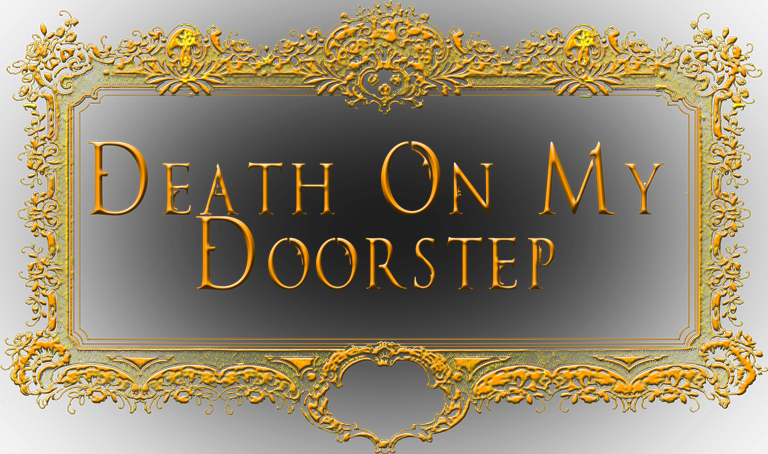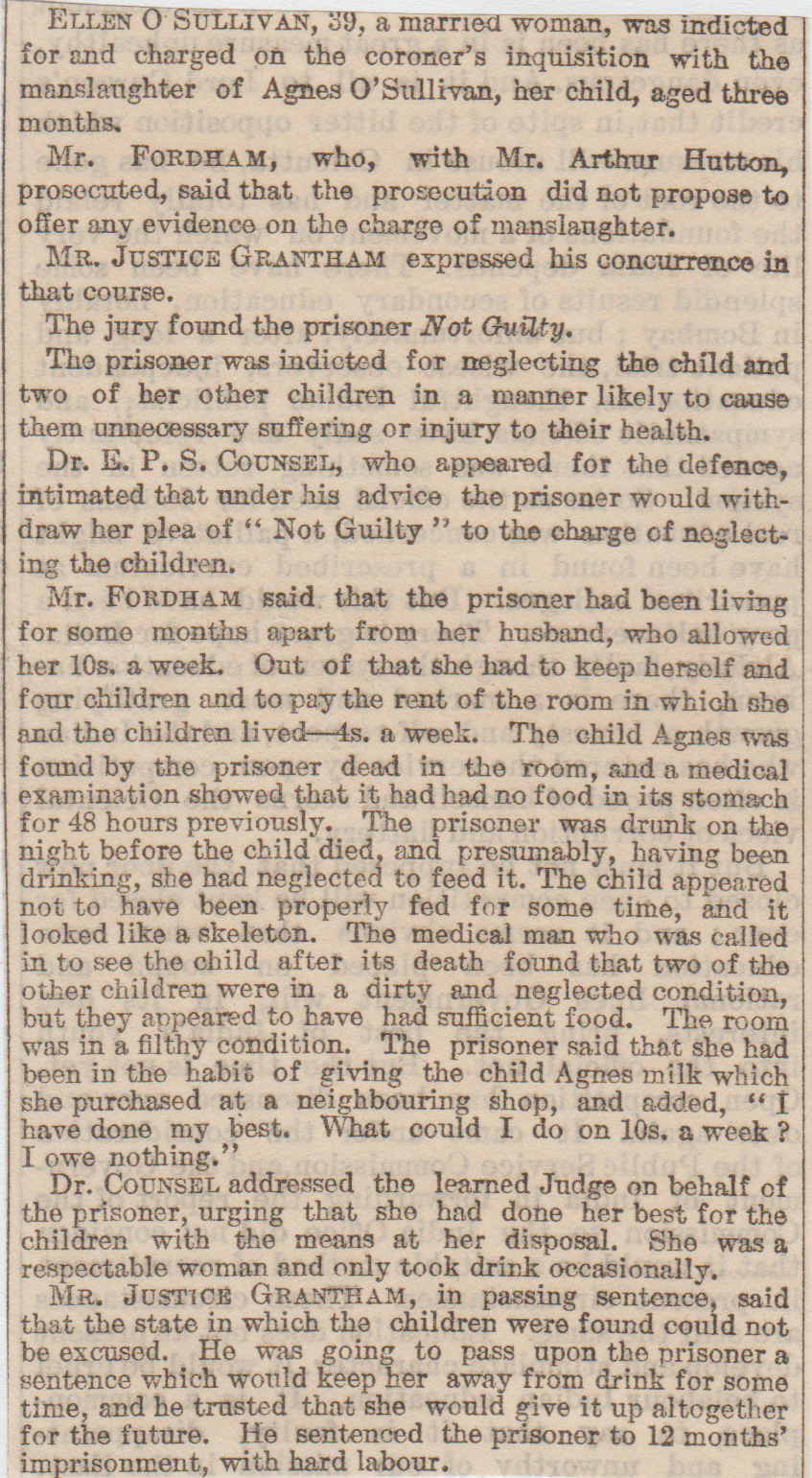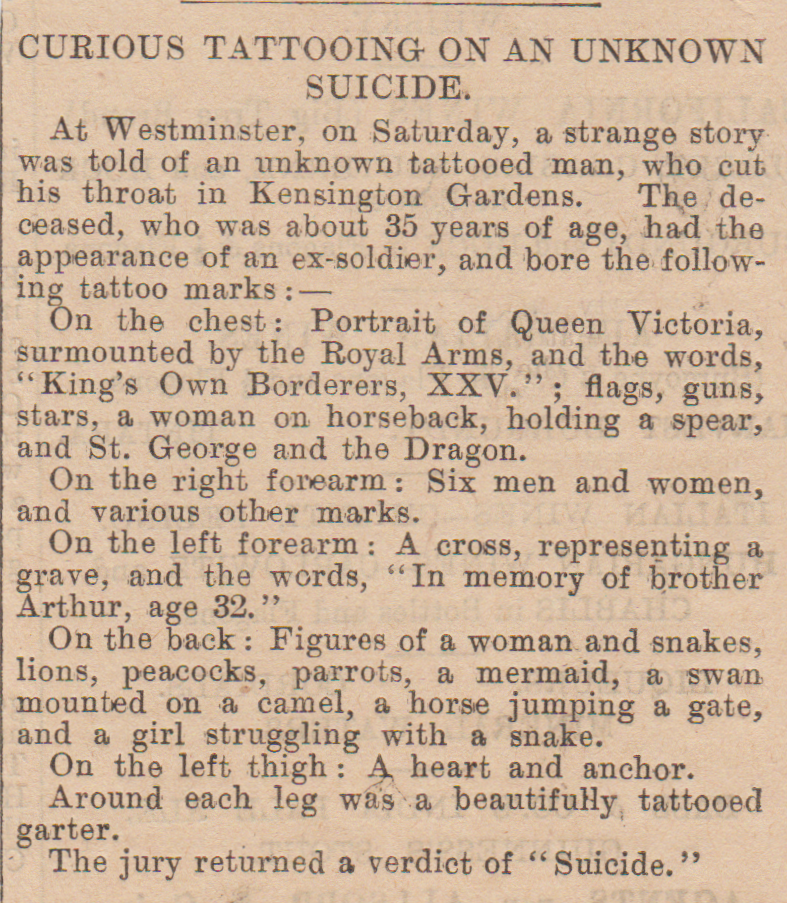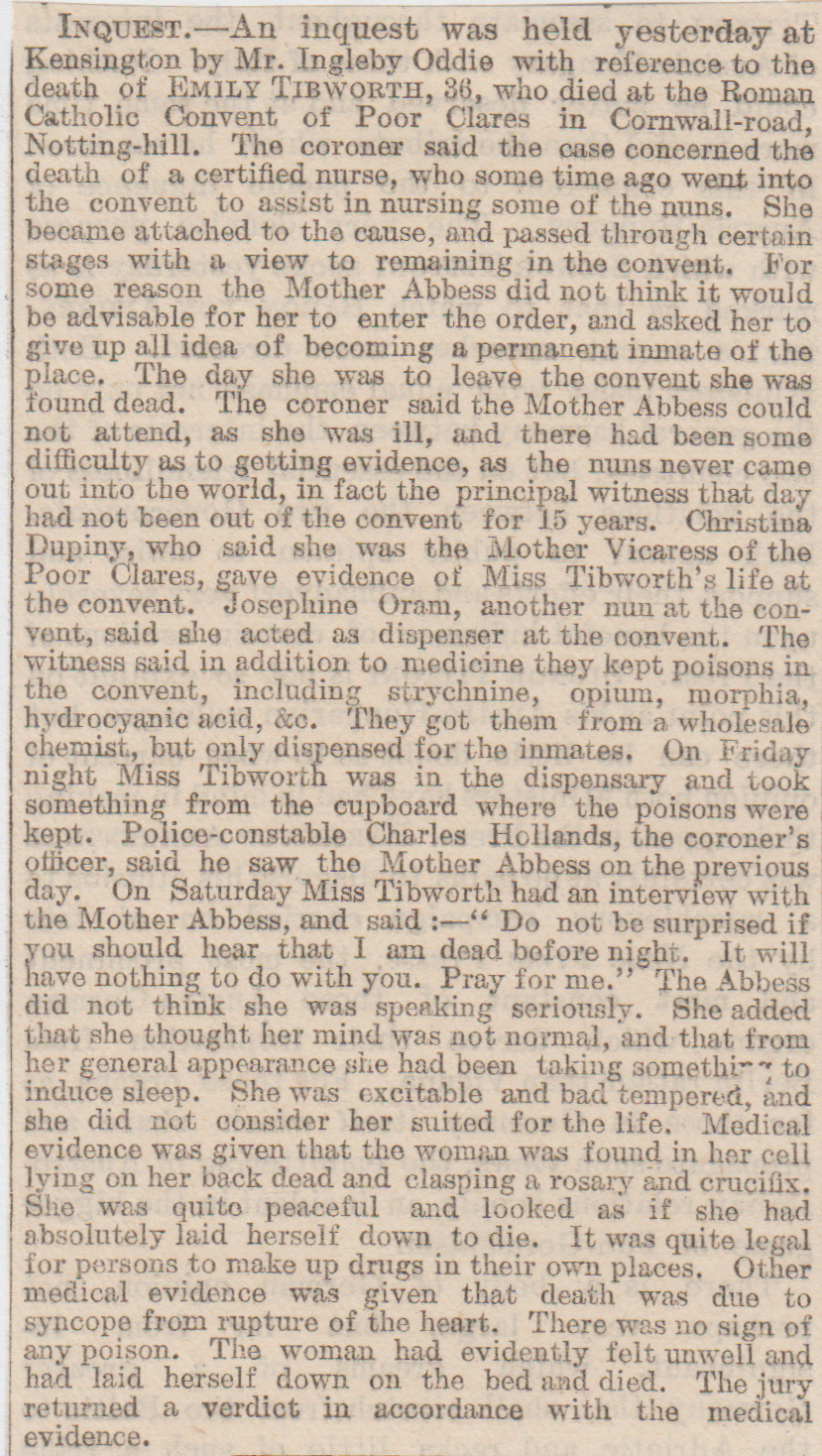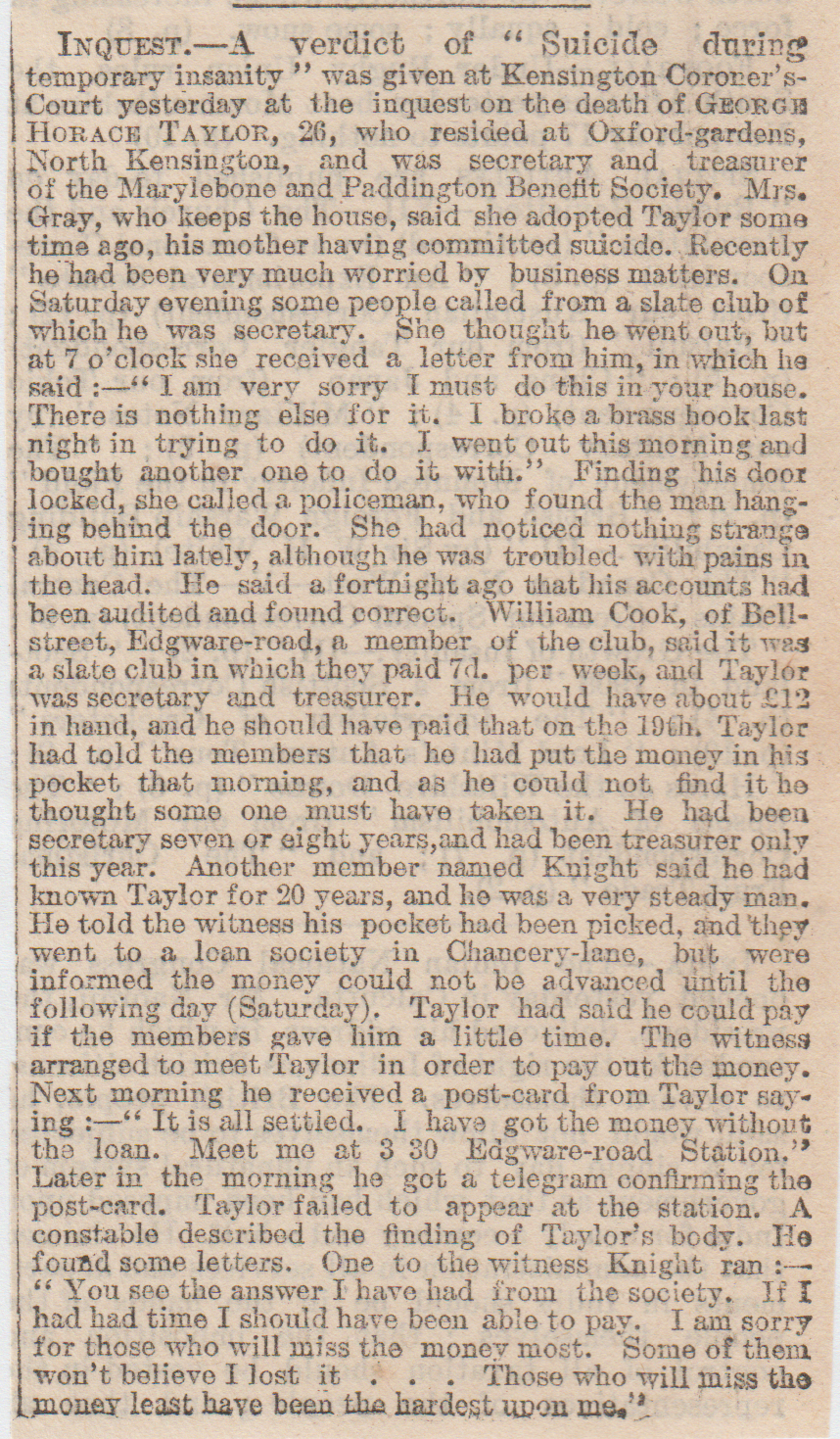1/ Chelsea Barracks, (Soldier Murdered) December 1876
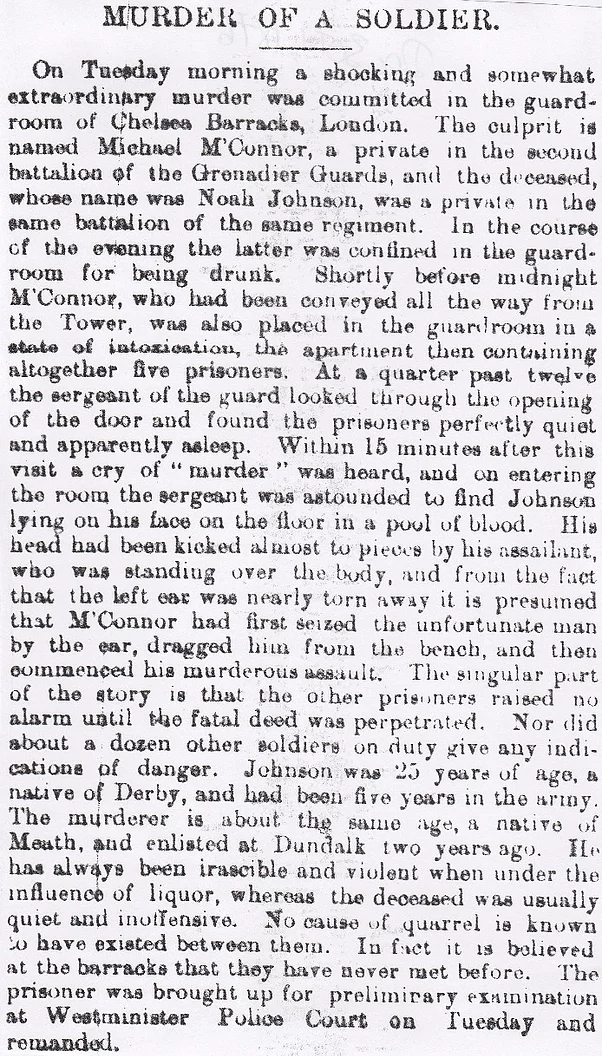
2/ Imperial Institute Lift Fatality, (Now Commonwealth Institute) August 1895
Frank Ragget aged fourteen, worked for the District Boys Messenger Co. at their office in Gloucester Road. The International Geographical Congress Committee was in town and Ragget was waiting for a message to come his way but he got bored and started messing about with the lift. He was scolded a couple of times and then he vanished. A search for the boy revealed him to be a the bottom of the lift shaft, badly mangled. It is thought that he opened the doors and got in without looking, then disappeared to the bottom. It was at Exhibition Road in South Kensington.
3/ Brompton Cemetery Murder/Suicide, August 1892
A terrible tragedy occurred at Brompton Cemetery and ended up with one girl dead and the murderer killing himself further away. James Boursell aged twenty-six and living at No 7, Vesper Road, Shepherd’s Bush, along with Alice Harriet Franklin a twenty-two-year-old domestic servant, were the two victims in this strange story. Alice’s sister, Emily, explained to police what happened. They went to put flowers on her auntie’s grave with a few other girls in tow as well, at Brompton Cemetery, when they heard a gunshot and looking behind them, they saw Boursell with a pistol in his hand. Alice fell down dead and as the girls were screaming and running towards the exit gates, Boursell then shot himself four times in the stomach and killed himself. (Did he die in Cemetery?)
4/ Kensington Palace (Lunatic Wandering About) February 1888
Kurt Degener was charged on Monday at Marlborough Street Police Court, with being a lunatic wandering at large near Kensington Palace. He had given to a constable an envelope addressed to himself as ” His Majesty Kurt Degener, Emperor of China and King of England”. Captain von Rodeir of the German Consulate, said he was ready to take charge of Mr Degener and send him home to Germany.Mr Newton, therefore, discharged him.
5/ Rutland Gate, Knightsbridge, (Impaled on Railings) March 1898

6/ Chelsea Church Suicide, June 1841
A man of about fifty years of age asked a churchwarden of Chelsea if he could go to the top of the tower so that he could draw Westminster Abbey. He was granted permission and went up with a bellringer. Then, after a few minutes, the bellringer came down and just after he reached terra firma, the unknown artist threw himself off the tower, a height of two hundred feet or more. He was smashed to a pulp on impact with the pavement. Papers found on the body have the name of Lloyd and an address in Leamington Spa in Warwickshire and this could be the guy. (Was it St Luke’s?)
7/ Earl’s Court Child Murder/Suicide, November 18905
Mrs Hall aged thirty-five and her four-year-old daughter, Gladys, lived at Child Street, Earl’s Court. The child’s mother and father had split up and Mrs Hall became slightly manic after their separation. When her sister, Mrs Long, went to call on her, she found little Gladys strangled to death in her mother’s bed, and Mrs Hall was discovered hanging from a hook in the backyard.
8/ Brompton Cemetery Suicide, September 1888
This was four years before the Boursell incident in the same cemetery. This lady, who was suffering from depression at the time went into Brompton Cemetery and swallowed some laudanum, then lay down to die on her parents grave. She was found unconscious and rushed off to Kensington Infirmary, but she died later on that day.
9/ Chelsea, (Freak Accident) December 1836
Mr Rivers, a Chelsea butcher, had in his employ, William Heath. While standing on a pair of steps in the shop, putting some meat on a hook, the steps snapped and he fell forward, with the hook impaling the roof of his mouth. He was left dangling there for several minutes until he was lifted off and given medical assistance. He is a precarious condition.
10/ Kensington High Road, June 1885 (Fatal Accident)
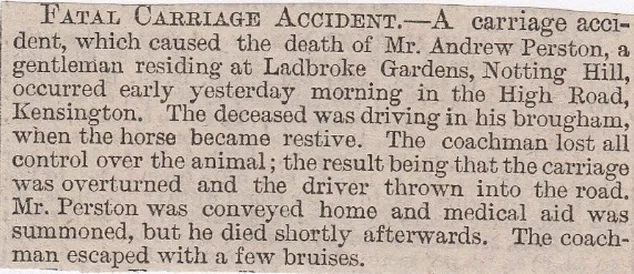
11/ Ediths Gardens Haunted House, West Kensington, August 1900
Local gossip around West Kensington of the possibility of a haunted house in Ediths Gardens, have had rubberneckers out on a night time, wanting to see the phantom. Police have had to be deployed to keep the gathering crowds from destroying and vandalising the property. A wall has been knocked over, windows smashed and doors battered down to gain entry. The supposed ghost is described as a deaths head which was visible in a narrow window and the whole affair is to be treated as a hoax.
12/ Eccleston Square Skeleton, South Belgravia, January 1880
John Lacey was working in the basement of a house in Eccleston Square and went into a vault which was used to store coal. In in a little nook behind a cistern, he spotted something that looked like a coconut. He grabbed some tongs and pulled it out, then reeled in horror when he saw it was a human skull. He had dropped it and broken it in two. Police were informed of the find and the bloke who was the manager of the firm who was working at the property, a Mr Dawson, told them what had happened. Police forensic team had dug up the rest of the skeleton, which was curled up, as though to make it fit into the tiny space it was being shoved in. The arms were broken and the vertebrae were bent over the thigh bones. The police surgeon said it was not an adult but a child of numerous years. The present owners have been here seven years and have often complained at the terrible stench, which they thought was drains being blocked. (Who was it?)
13/ Knightsbridge Suicide, May 1857
Mr Benjamin Tate was very depressed about the passing away of his beloved mother. He had taken lodgings at Mr Kibbles, Old King’s Head Tavern, Knightsbridge. At the breakfast table one morning, there was no sign of Tate, so Mr Kibble went upstairs to get him thinking he had overslept. He was discovered with his throat slit and the suicide weapon, a razor, under the still warm body.
14/ Durham Place Suicide, Chelsea, June 1899 (Still there)
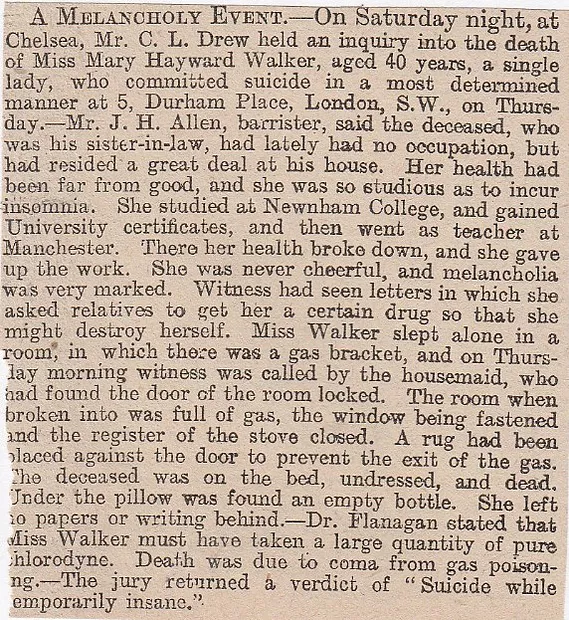
15/ Sloane Street Suicide, Chelsea, December 1865
Between seven and eight o’clock one evening at 115, Sloane Street in Chelsea (Durley House), a teenage girl jumped from the second-floor window. On her way down, she hit a balcony and then landed on the pavement. The girl was dead and had her brain matter scattered all over. Apparently, she only arrived last week, into this property, which is a home for young ladies. Suicide was preferable.
16/ Talbot Road Murder/Suicide, Kensington, August 1895
At lunchtime one day, the sudden report of two gunshots rang out from the top floor of 53, Talbot Road, in North Kensington. Police were called to the scene and found a guy called Mayston, a 30-year-old cab driver, had shot Mrs Mayston in the chest with a revolver. She was dead and Mayston himself was in a critical condition.
(Across the road from Shrewsbury Road- Still there)
17/ Chelsea, September 1859 (Killed Herself, Missed her Mistress)
Since the death of the Dowager Countess of Norbury (was it 1859?), a woman by the name of Mary Newnes had been inconsolable. Mary worked for her for thirteen years and yet she was only thirty-two. Her husband still worked there as the coachman. She just couldn’t accept that she’d gone, so she took some oxalic acid and killed herself. (Inquest at Chelsea Workhouse)
18/ Mill Street/Chelsea? December 1885 (Attempted Murder)
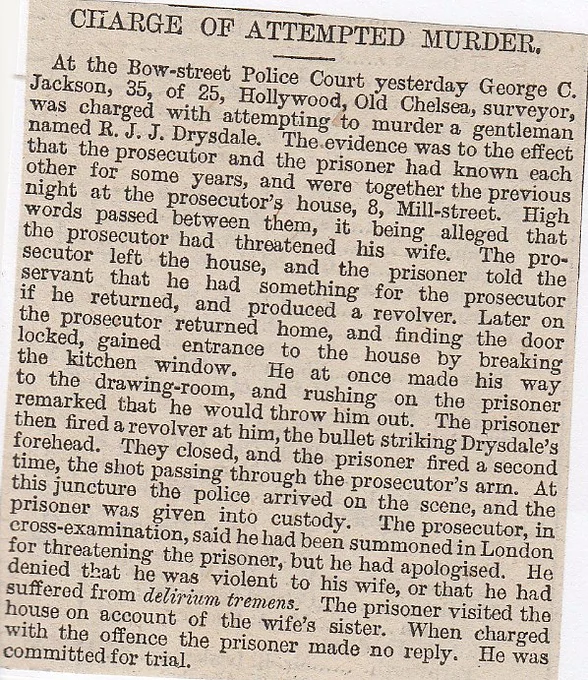
19/ Leader Street Fatality, Chelsea, April 1899
A strange fatality occurred on Monday night in Leader Street in Chelsea. A man named John Wright aged fifty had retired to rest for the night. Afterwards, the inmates of the upper portion of the building noticed a smell of fire and found it coming from the apartment occupied by Wright. There being no response to repeated knocking the door was forced open. The place was then in flames and although Wright was but slightly burnt, he was in an unconscious condition, having been overcome by the smoke and he succumbed in about half an hour. It is surmised that Wright whilst smoking had fallen asleep and the burning tobacco had set a light to the bed clothing and caused the fire.
20/ Kensington Palace Gardens, July 1908 (Lift Death)
Mr Leopold Hirsch of Kensington Palace Gardens had a tragic accident occur at his property. The forty-four-year-old head housekeeper, Eleanor Chalkley, was found by the steward with her head caught between the top of the lift and the top of the grate. It was a small hydraulic lift, made decades ago and was used to transport light articles up and down the building. It was poorly built and was asking for a serious accident to happen to it, as it possible to look over the sliding gate into the well, whereas the whole thing should be closed automatically before the lift could be re-started.
21/ Notting Hill, October 1892 (Murder or Suicide?)
Police can’t work out if this one was murder or a double suicide. Does anyone know what the end result was?
Two girls were found in the Grand Junction Canal in the Notting Hill and Westbourne Park area. They were embracing each other as though in a double suicide, but the plot thickens when a compromising letter was found in the eldest girl’s room. The two victims are-Mary White aged seventeen from Talbot Mews in Notting Hill and Ellen Mitchell aged fourteen of Blechynden Street, also in Notting Hill. Just to get one thing straight in all this, was that Notting Hill was not the swanky suburb we see Hugh Grant wafting up and down in. It was a slum and a no-go area for wealthier members of London society. When the girls were found they had or two marks on them, but they might have been from boats or barges, also they had circular marks on their wrists, but nothing to show they were bound together. They left home a week or so ago to look for work and police surgeons had estimated the bodies to have been in the water for five days. A man said he saw two girls of similar description in Kensal Green who were with a bloke, but they couldn’t find him. While searching through Mary White’s clothing, they are supposed to have found a “compromising letter” from a bloke in Homerton. The number of rumours going about the district, it could well be false.
22/ Harrod’s Store’s, July 1895 (Thieving Store Detective)
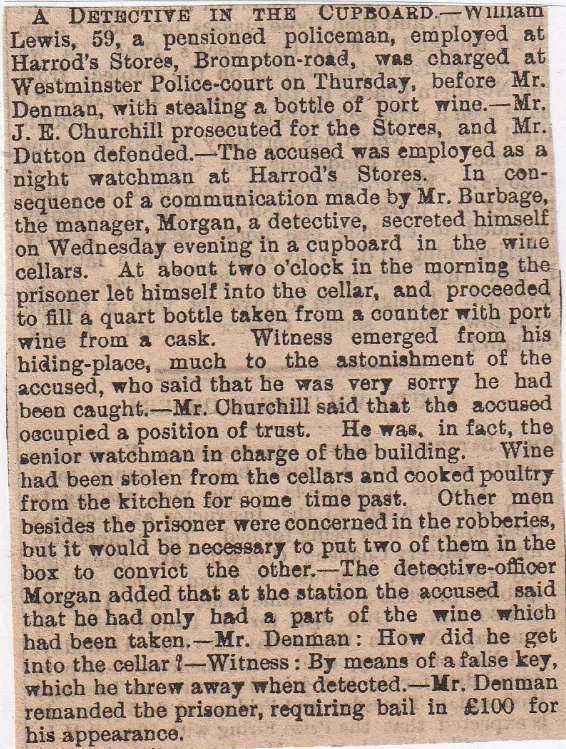
23/ Edith Grove, Chelsea, February 1896 (Impaled on Railings)
Mr Organ, who worked as a traveller for a Dundee firm of whisky distillers died in a singular accident in Edith Grove in Chelsea. Mr Organ had caused a crowd to assemble in the Kings Road, Chelsea, by acting in an eccentric manner. The crowd followed him to his home in Edith Grove and he appeared at his drawing room window addressing different questions. One lad jeered and this got him mad, so he climbed the widow-sill. Then a struggle ensued between himself and some friends in the room and while pulling and tugging, they let loose their grasp and he crawled along the ledge. He fell forward and became impaled on the iron railings below. The sheer force of the fall snapped three railings clean off and died while being taken to St Georges Hospital.
24/ Hyde Park Gate, Kensington Road November 1859
The area around Hyde Park Gate was the scene of a dreadful accident which resulted in the death of a man carrying out work there. William Barnett was a master builder and well-known in the Kensington district and he was working at number 8 at Hyde Park Gate. These are very tall mansions of several floors and Barnett was checking on some masonry work in the cornice when he fell about eighty feet to the ground, smashing himself to atoms. He died at St Georges Hospital later on that day.
25/ Chelsea Dock, (Suicide for Sixpence) June 1878
Sixteen-year-old Joseph Henry Sooley worked in a solicitor’s office in Piccadilly, and left for work one day but never returned home. The next day a letter dropped on his father’s doormat and it was from his son. It said that he’d been accused of stealing a marked sixpence but he was not guilty of the crime, so he decided to commit suicide instead, by drowning himself in the Thames. Rather thoughtfully he had pawned his watch before jumping in the river and sent the ticket to his Mum. His father said he was very sensitive and two years ago he had lost a couple of fingers in a machine accident and this made him extremely nervy. The body was found near Chelsea Dock and had been there for quite a number of days. Died for a sixpence!
26/ Talbot Grove, Notting Hill, December 8th, 1885 (Threw Child from Window)
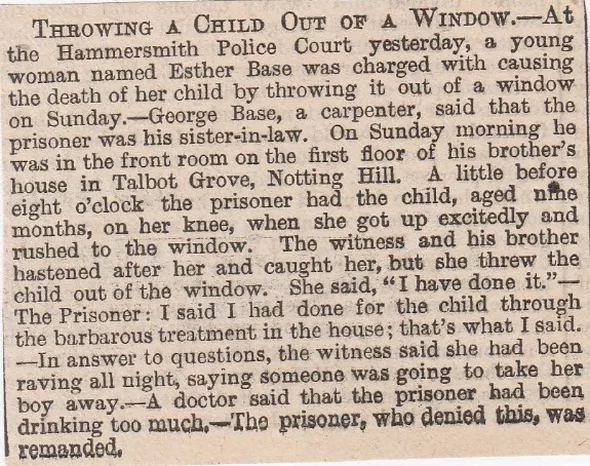
27/ Talbot Grove, Notting Hill, December 15th, 1885
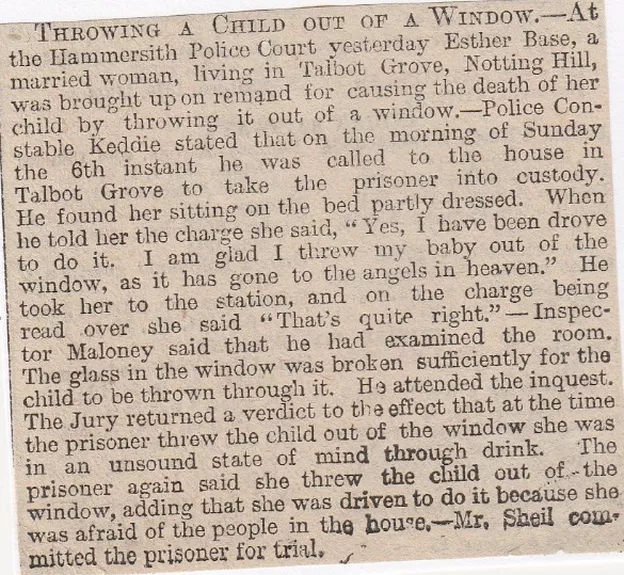
28/ Chelsea College, November 1852 (Deaths at Wellington’s Funeral)
Thousands lined the streets to pay their respects to the Duke of Wellington. Huge crowds assembled in front of the hospital, with nowhere near enough police having been deployed. It was waiting for an accident to happen and around twelve o’clock, the rumour spread that several had been killed already and were taken to St Luke’s workhouse. Thousands went home and the police force was boosted to seven hundred men. Still, the numbers were immense and two women were confirmed as casualties of being squashed to death in the crowd. The crowding in Chelsea was particularly bad and it is thought the two women were in this general area, but 60,000 saw the “Iron Duke” lying in state with no accidents.
29/ Belgravia Suicide, November 1873
Mr Drummond of 11, Wilton Crescent employed Percy Hayling as a footman. For quite a few months, Percy had been getting terrible pains in his head and told other members of staff that he wanted to kill himself. One day, Percy went missing from the kitchen, so the under-footman went upstairs to his room to get him. On opening the door he found him with a gunshot wound to the temple and a pistol in his hand. Strange thing was, that nobody heard a single shot being fired. The surgeon who was called in, said that he put the muzzle in his mouth, which acted as a silencer, hence no-one hearing a sound.
30/ Kensington High Street/Notting Hill Gate Stations, February 1913 (Murder or Suicide?)
A wealthy lady’s headless body was discovered in the tunnel between the tube stations of Kensington High Street and Notting Hill Gate. Miss Maud Frances Davies was also stabbed a couple of times, with one directly in the heart. Only last week she had docked at Liverpool from a trip to New York and just got into London. Her whereabouts on Saturday are unaccounted for and she also didn’t contact any friends or family and left her luggage at Euston Station. A ganger found her corpse in the tunnel at two o’clock in the morning, with no valuables having been taken either. (How did she get there?)
31/ Chelsea Soldier Murder, December 11th, 1885
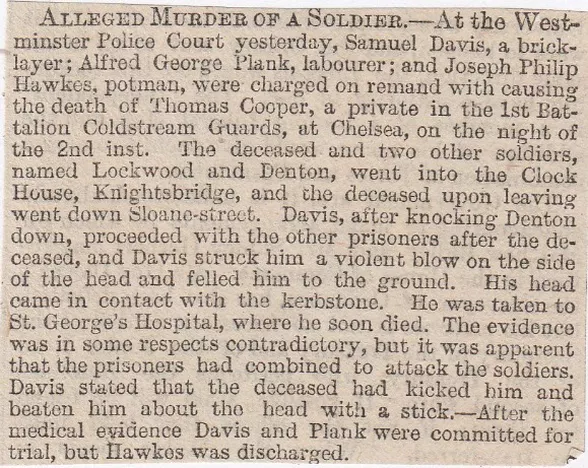
32/ Chelsea Manslaughter, December 18th, 1885

33/ Chelsea, (Funeral Turns Nasty) September 1854
Miss Phoebe Todd had it all. She was the daughter of rich parents and said to be the best looking lass in all of Chelsea, so she had the men clamouring to get a date with her. Nobody was suitable as far as her father was concerned, so he picked one out himself. It was a young man by the name of Anderson and he was going to marry her and whisk her off to India. Phoebe wasn’t keen at all, but her father was adamant and he was going to arrange the wedding with Anderson. While he was gone Phoebe went to the W.C. and slit her throat with a razor. Word got around Chelsea about what had happened and as they were preparing to bury Phoebe, a crowd assembled outside Mr Todd’s house, mainly packed with female’s angry at the treatment of his daughter. As the coffin was being put on the hearse, the crowd muttered “Poor Phoebe”, and the women began to cry. When Mr Todd came out they began to jeer and hiss and this carried on all the way to St Luke’s at Chelsea, where she was buried. A police presence was used and was much needed because if they hadn’t been there, they would have ripped the two men to shreds.
34/ Kensington Court Place Suicide, February 1892
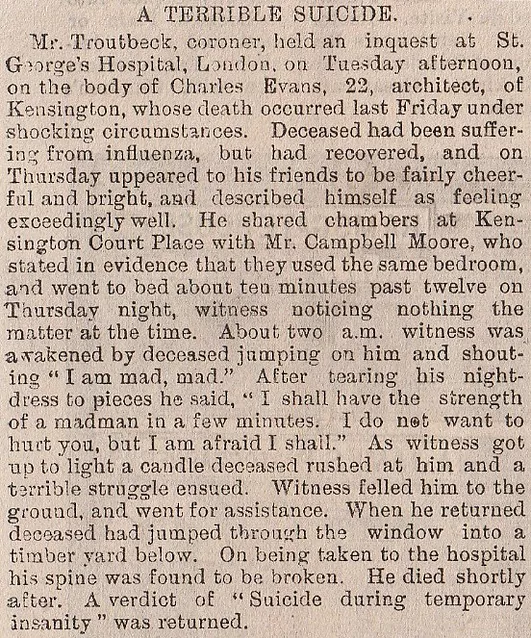
Found out that it was at number 18, Kensington Court Place and that is near the High Street in Kensington. The other bloke’s full name was Herbert Campbell Moore. The apartment window he jumped from, was thirty-three-feet from the ground on the second floor. When admitted to the hospital, he died three hours later.
35/ Onslow Gardens Suicide, South Kensington, August 1892
The sound of gunfire rang out over Ensor Mews, Onslow Gardens in Kensington. The person behind the firing was George West, whose father works as a footman in Onslow Gardens and ended in his self-destruction. West was on leave from the Suffolk Regiment and the reason for his suicide was that he had nicked something and was threatened with arrest. Two policemen went to arrest him at noon and he had climbed onto the roof of Endor Mews to escape the handcuffs. He seemed to shoot several chambers harmlessly into the air, but he saved the last bullet for himself. Some decorators were at Onslow Gardens doing some work and heard the shots, they then tried to get to the roof where the fellow was having his manic episode. West put the gun muzzle in his mouth and fired upwards, blowing the top of his head away.
36/ Earl’s Court Station, (Fatal Collision) August 1885
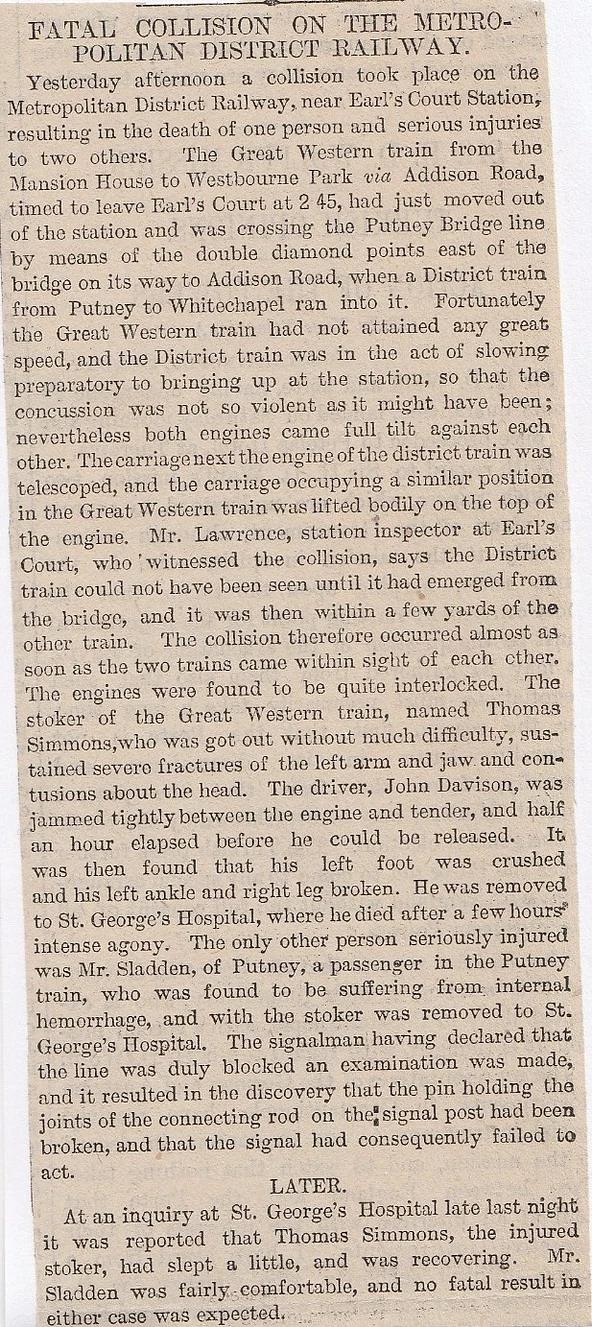
37/ Bangor Street, North Kensington, March 1895 (Professor Starved to Death)
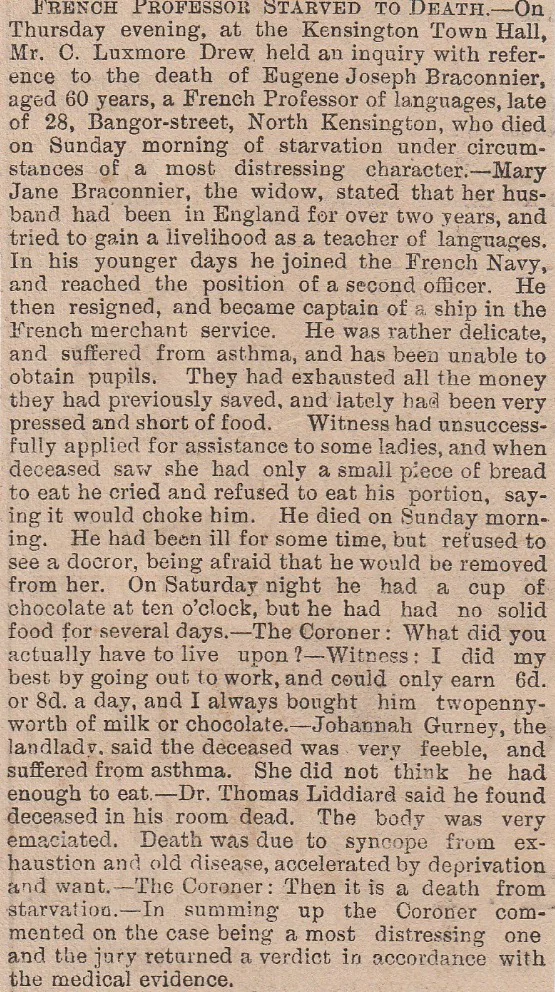
38/ Warwick Square Suicide, Kensington, July 1853
Twenty-three-year-old Abraham Giles blew his brains out in Warwick square in Kensington, all because his girlfriend had broken up with him. He was found lying on the pavement, with a fatal head-shot and a horse pistol next to him. The girl all this was about was Catherine Tedding, a nice-looking twenty-year-old, who worked as a domestic servant to Miss Patrick at No 5, Warwick Square. She had been going out with him for a year, but then her friends told her to dump him and don’t get married. Catherine took their advice, but this was a devastating blow to Giles, who took it very personally. Around three months ago he told her that he had some loaded guns at home and would shoot himself and then a few days ago he came to her mistress’s house and spoke to her through the railings, telling her he was off to work in the country and had come to say goodbye. In typical Victorian England style, with no love or emotion involved, they shook hands and she said goodnight. Catherine thought that was the end of the matter, but when she got upstairs to her room, she looked out of the window and she saw him in the exact same spot as when she left him. He put the gun in his mouth and fired while she watched on. – Giles wrote some letters-including one to Catherine, saying that if she did not marry him, then he would kill himself and then fall by her side. The verdict was a short and simple one-“Insanity”.
39/ Abingdon Villas Poisoning, Kensington, July 1895
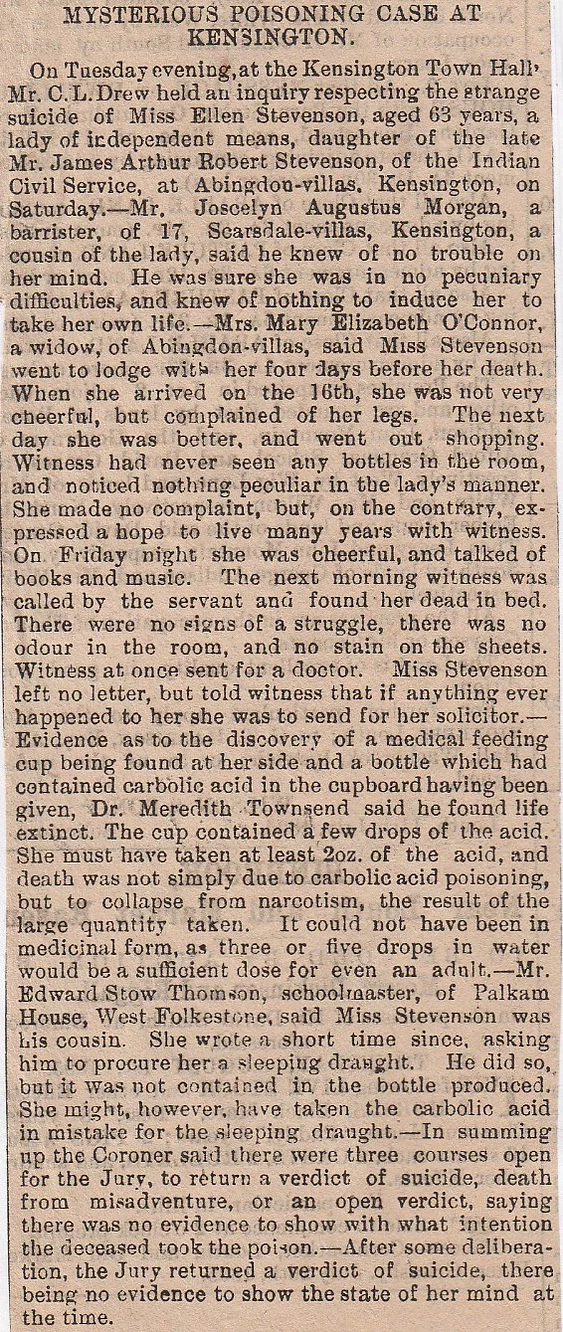
40/ South Kensington Fatality, September 1885 (The International Inventions Exhibition was held at South Kensington in 1885)
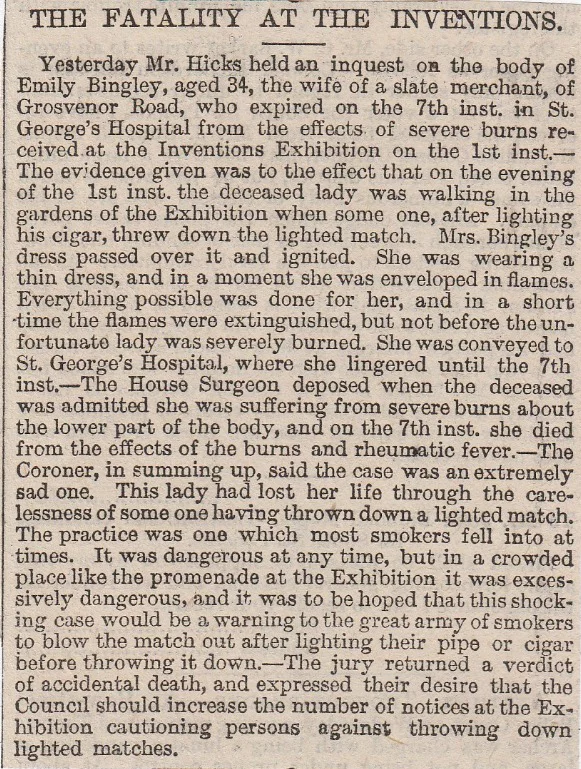
41/ Chelsea Murder? December 1870

42/ Glendhow Gardens Murder, Kensington August 1870. (Drayton Arms pub still doing business. No.3 is one of those big white gaffs on the A3218)
August 31st, 1870.
Although several weeks have passed since the murder of Samuel Lee, potman at the Drayton Arms, West Brompton, the detectives of the Metropolitan Police have failed to discover any clue to the guilty persons. It was said that after the conclusion of the coroner’s inquest the police received some important information connected with the matter, but upon making a careful inquiry it was found that the statement made to them was false. Yesterday a reward of £100 was offered by the Government for the arrest of the murderer. A subscription has been opened for the assistance of Mrs Lee, who has been left with a family.
43/ Starvation of a Child, North Kensington. February 29th,1904
At Marylebone, Ellen O’Sullivan, 38, married, living at Bosworth Road, North Kensington, was brought before Mr Plowden on a coroner’s warrant charged with causing the death of her infant child Agnes, aged three months, by starvation. An inquest was held on Friday, and the jury returned a verdict of manslaughter against her, and she was then arrested by Inspector Pollard, X Division.
